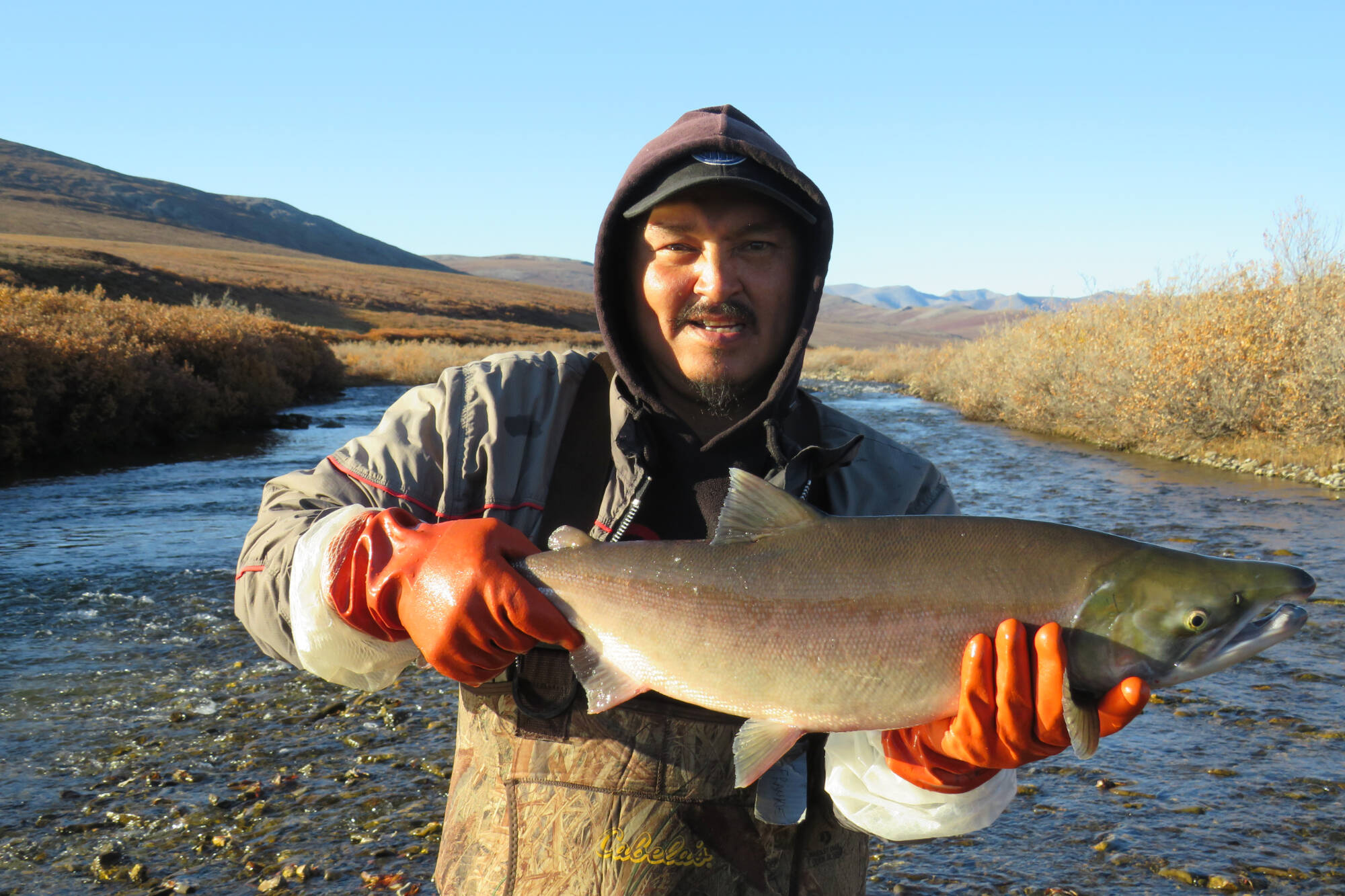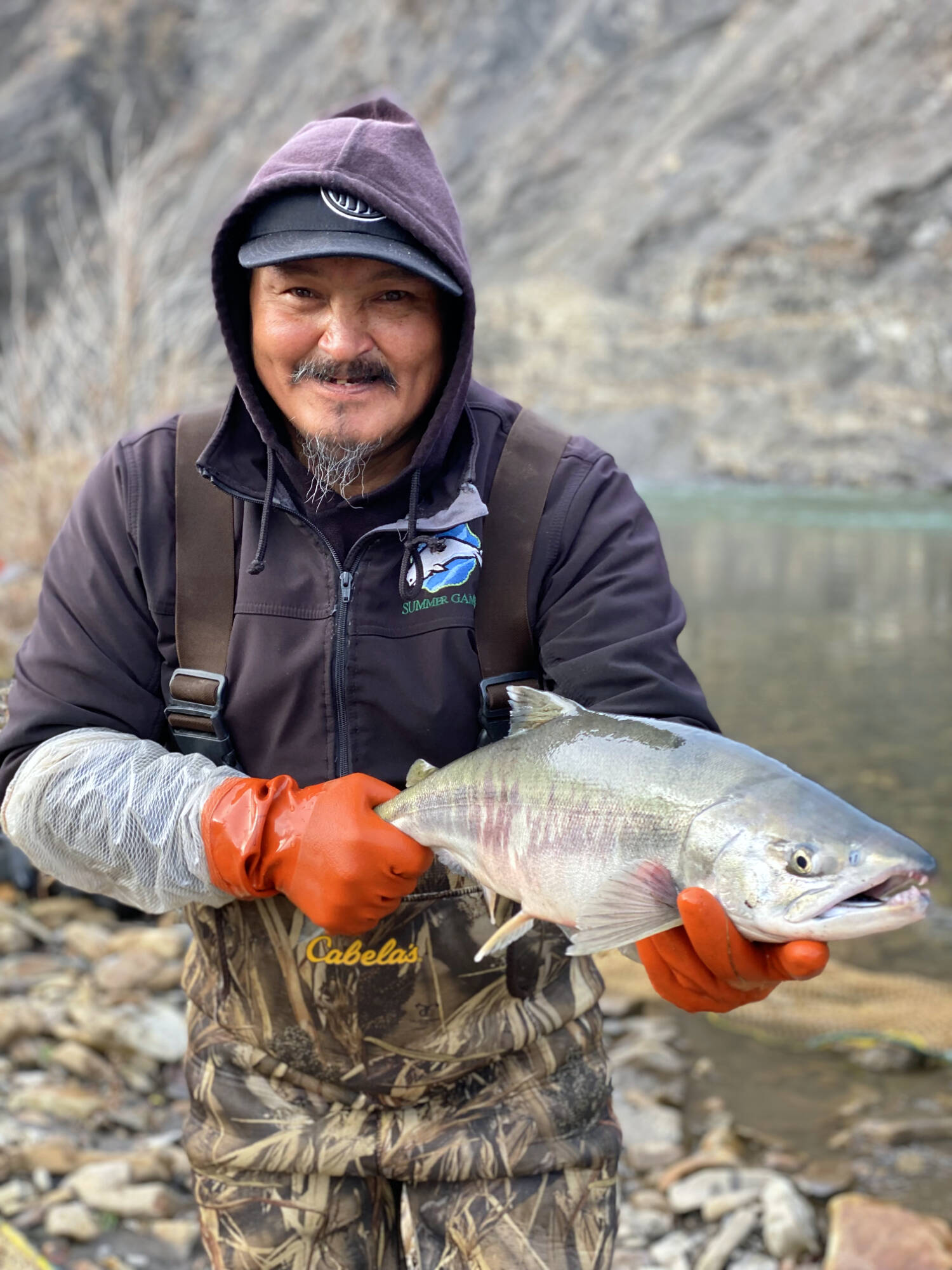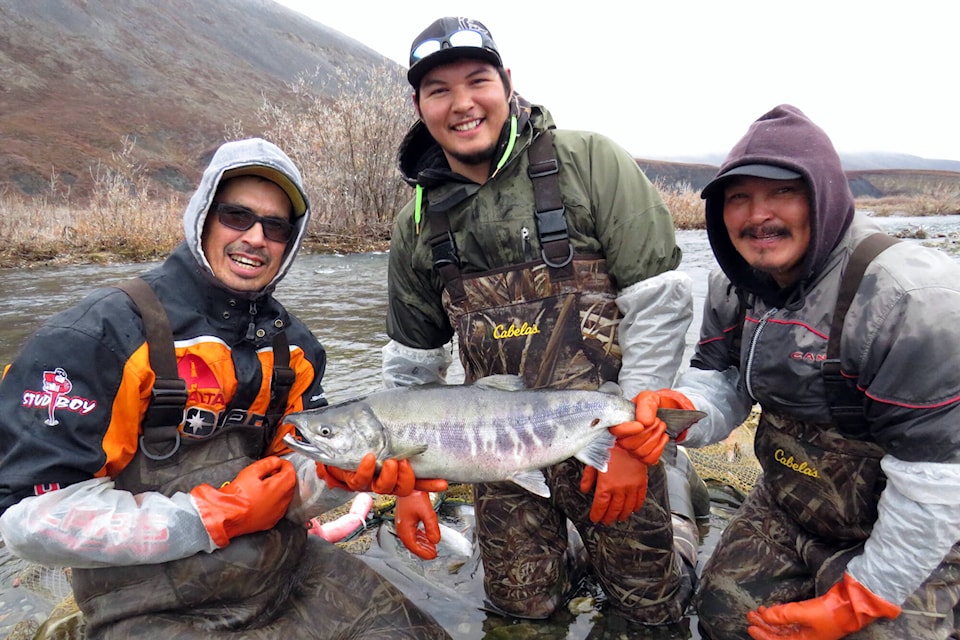Since 2009, Colin Gallagher has made regular pilgrimages to count fish in rivers running through the imposing expanse of the Yukon’s North Slope and neighbouring areas in the Northwest Territories.
A biologist with the stock assessment group for Fisheries and Oceans Canada (DFO), Gallagher’s aim on these northern adventures is to learn more about the health of populations of Arctic char in N.W.T. and dolly varden in the northern Yukon.
To complete this work, Gallagher and Indigenous partners who reside in the region visit waterways where they deploy seine nets to get a sample of the species and number of fish in a given area. In the Yukon’s far northern reaches, Gallagher says they encounter dolly varden, a species of char, and “a lot of grayling.”
Over the past seven or eight years, though, unexpected visitors have begun showing up in their nets: Pacific salmon.
“What we’ve noticed in these more recent years is that, all of a sudden, we’re catching salmon […] The first one we came across was in 2016,” Gallagher tells the News by phone from his office in Winnipeg, adding that the salmon numbers his team sees in Arctic rivers are still “quite low.”
He says when a salmon gets caught in their research nets, they’re alerted to its presence pretty quickly. While dolly varden and other fish species tend to eventually “calm down” while in the net, salmon go berserk.
“[Salmon] go crazy in the net. You know that something is going on when you have this fish that’s jumping, jumping, jumping in there and, like, going crazy […] yeah, it’s probably a salmon,” Gallagher says.
This year, Gallagher and the team he works with encountered only one salmon — a chum. He says the most salmon they’ve seen was approximately eight sockeye salmon in 2019 in the Yukon’s Firth River, a major waterway that empties into the Beaufort Sea just south of Herschel Island.
“As we’re walking around, we noticed these red, red fish — and that’s not like dolly varden. [Dolly varden] have nice coloration, but not that intense red that we saw in the water […] Sure enough, we put a camera in the water, and it was these sockeye salmon […] And it was roughly about eight or so fish that we figured we saw there at that particular pool,” Gallagher says, adding that he’s sure that there was more sockeye in the river system.
“We’re assuming that there’s probably more in the river system — we just haven’t seen them.”

Gallagher says he’s mainly come across sockeye and chum in the Arctic rivers he’s observing. However, a technical report for the North Pacific Anadromous Fish Commission provided to the News indicates that all five commonly recognized Pacific salmon species — chinook, chum, coho, pink and sockeye — have been spotted in the Canadian Arctic.
Data collected by the Arctic Salmon community-based monitoring program between 2000 and 2020 shows that chum salmon were the most-caught Pacific salmon by harvesters in the Arctic. Sockeye and pink salmon were the second and third most caught, while chinook and coho were the least caught. Only two coho were captured during the 20-year period, one in 2011 and another in 2019.
The technical report also notes that subsistence fishers have occasionally caught Atlantic salmon in Nunavut.
Salmon arriving in the Canadian Arctic is not a new phenomenon. According to Karen Dunmall, an Arctic research scientist with the DFO and the Arctic Salmon and Arctic Coast team leader, they “have been caught up the Mackenzie River system for generations.”
She notes that communities in the Inuvialuit settlement region have a long history of harvesting chum in the Mackenzie River Delta. In contrast, communities on the outer islands further east of the delta have a much shorter history of catching chum, dating back to “2004, 2008 or even 2012 or later.”
“What has changed is the number of chum salmon that are appearing is increasing generally, although it goes up and down quite a bit year to year. And then the other species of Pacific salmon are also now appearing in the western Canadian Arctic, especially pink salmon and also sockeye salmon, and some years — less so — chinook and coho,” Dunmall tells the News.
It’s fair to note that the presence of salmon in Arctic waterways has gained increased attention in recent months. Back in October, researchers in Alaska confirmed that chum salmon are actively spawning in two rivers on the state’s North Slope. The announcement generated considerable buzz, with numerous Canadian and American media outlets running the story.

It’s unknown whether the chum documented spawning in Alaska successfully reproduced. Gallagher says that the salmon he’s seen in northern Canada were either preparing to spawn or had spawning colouration but that he can’t comment on whether they were successful or not.
He also notes that he’s encountered one salmon carcass on the Yukon’s North Slope during winter and that the fish may have died after spawning.
“We spotted a salmon carcass, [it] presumably died after spawning, but whether those eggs are successful or not, I can’t say. But obviously, the fish did attempt to spawn, presumably, and then died,” Gallagher says, adding that the carcass was near a perennial groundwater spring that doesn’t freeze during winter.
Dunmall does note, however, that at least some salmon have been successfully reproducing in the North American Arctic. She cites the capture of a juvenile chum salmon near Kaktovik as “definitive evidence that they are successful at spawning and incubating over the winter and that the juveniles can actually access and use the nearshore marine habitat.”
She also notes that salmon do things in the Arctic that they don’t usually do elsewhere, such as hunt in freshwater.
“Pacific salmon are thought elsewhere in their distribution to focus all of their energy and effort once they hit the freshwater into spawning because they die after they spawn. So they’re not thought to eat very much in the freshwater. Whereas people in the Canadian Arctic noticed that they’re catching them on hook and line at certain times, and also that they’re eating actively in the freshwater,” Dunmall tells the News.
As for why salmon are turning up in the Arctic in recent years, climate change is the most common suggestion. The technical report mentioned earlier states that warming water temperatures push optimal marine habitats for salmon northward. An online news release from the University of Alaska Fairbanks in October also suggested that salmon species could expand north as “climate change reshapes their habitat.”
“It does have to do with water temperatures in the ocean and the sea ice and sort of the timing of that process,” Dunmall says, adding that warmer temperatures and less ice make northern habitats more suitable to salmon.

But while it might be tempting to view the arrival of salmon species in the Arctic as a positive sign that they’ll be able to adapt and survive in a world with a changing climate, experts are quick to point out the impact the newcomers could have on endemic species such as dolly varden and Arctic char. Salmon could compete for the same food sources as native Arctic fish, and there is the possibility they introduce new diseases to northern fish species.
“There are examples in Alaska where char species dolly varden and salmon overlap and can live together, but those systems have evolved that way. These [northern Canadian rivers] are essentially systems that, to our knowledge, haven’t evolved with salmon. So, as soon as you introduce the potential for a new species in here, the first thought that comes to mind is that this might not be a good thing,” Gallagher says.
He additionally notes that if salmon do negatively impact char populations, it would likely have undesirable consequences for the subsistence fisheries of local Indigenous groups.
Asked whether the arrival of salmon in the Arctic is a good or bad omen, Dunmall says it depends on a person’s perspective.
“It could mean, you know, an opportunity for something different to harvest. But it also could mean that it impacts the species currently in the Arctic. In either case, it is definitely a sign of things that are changing, and they’re changing rapidly in the Arctic,” Dunmall says.
If you live in the Arctic and are interested in reporting a salmon catch or sighting, please visit www.arcticsalmon.ca
Contact Matthew Bossons at matthew.bossons@yukon-news.com
